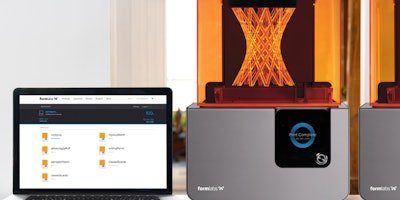
FORMLABS WHITE PAPER:
When to 3D Print In House
and When to Outsource
formlabs.com
FORMLABS WHITE PAPER: When to 3D Print In House and When to Outsource 2
Prototyping with 3D printing helps teams communicate with stakeholders and ultimately
results in better end products. At a relatively low cost, teams can show 3D printed
prototypes to customers, business partners, and people across the company. Designers
can receive feedback and quickly iterate designs. High quality visual prototypes can
be used for marketing and sales. Functional prototypes can be user tested and quickly
revised, resulting in an end product that meets customer needs.
Prototyping with 3D printing helps teams communicate with
stakeholders and ultimately results in better end products.
There are three main methods of prototyping with 3D printing: you can outsource to
a 3D printing service bureau, 3D print in house with industrial machines, or 3D print
in house with desktop 3D printers.
FORMLABS WHITE PAPER: When to 3D Print In House and When to Outsource 3
3D Printing Methods: Overview
3D PRINTING SERVICE BUREAUS
Service bureaus are best for low quantity and high complexity. Choose this option if you
need less than 5 parts per month, especially if those parts are large and call for non-
standard materials. Service bureaus are also useful when your parts have very different
materials or applications. In other cases, this is by far the slowest and priciest option.
IN-HOUSE INDUSTRIAL 3D PRINTERS
In-house industrial 3D printers are a solid option for large batches of parts (200 a week
or more) with the same material and a size over 30cm³. Still, industrial machines are
often not used enough to make the cost worthwhile, unlike desktop machines.
DESKTOP 3D PRINTERS
Desktop 3D printers are great when you need parts quickly. If you print a large batch of
parts (200+) per week, then a print farm of multiple desktop machines is cheaper than
and just as effective as an industrial machine. Multiple printers would also give you more
flexibility and would give you access to several materials at once. Service bureaus can
be occasionally added to this flexible workflow if you occasionally need larger parts or
uncommon materials.
Black and flexible resin brush
prototype, printed on The Form 2.
FORMLABS WHITE PAPER: When to 3D Print In House and When to Outsource 4
3D Printing Methods: Pros and Cons
METHOD PROS CONS
Service Bureau
Usually have several technologies in
house such as SLA, FDM, and SLS.
Higher cost than in-house desktop and
(at a high throughput) industrial 3D printers.
Have more materials available than
an in-house system.
Much slower than in-house 3D printing
(can take several weeks instead of one day).
The bureau can give advice on the
best materials and their limitations.
If you’re not pleased with the bureau,
it’s easy to fire and forget.
Industrial 3D Printer
Lets you take a deep dive into the
technology.
Significant investment: about $30,000 for
an entry-level system, $300,000 for a true
manufacturing system.
Quicker than service bureaus.
True manufacturing systems require over 30m²
of floor space, industrial HVAC, finishing
stations, cleaning stations, etc.
Lower cost than service bureaus at
high throughput.
For a true manufacturing system, accounting for
all costs, a single build would cost more than a
desktop 3D printer (Approximately $3,000 plus
usage and labor).
At a low throughput, this has a higher cost than
both service bureaus and desktop 3D printers.
Higher cost per part and higher TCO than
desktop 3D printers even at a high throughput.
Limited range of materials compared to service
bureaus.
Material cost for industrial machines ranges
from $45 to $360 per lb.
Requires an FTE.
Desktop 3D Printer Lowest up front investment.
Lower reliability and repeatability than
industrial machines.
Lowest cost per part and lowest TCO. Smaller build volume.
Quickest time to part.
Many desktop 3D printers don’t have
great warranties or support.
Lets you take a deep dive into the
technology.
Smallest form factor, lowest requirements
for your office, and least required space.
FORMLABS WHITE PAPER: When to 3D Print In House and When to Outsource 5
Which option is best for me?
The method you choose should be tailored specifically to your workflow and project
goals. Here are the biggest considerations before choosing the method that’s right
for your team:
• How many parts per week will you need?
• How quickly will you need your parts?
• What materials will you need?
• What is the function of your parts — visual display? Functional prototyping?
Casting into end products?
• How many of your parts can you fit into one build volume of a desktop and an
industrial machine?
• Order sample parts from various service bureaus and 3D printer manufacturers.
Ask each company to provide more information about the sample part such as:
how long did it take to print, how much material was used, and the layer thickness.
• Calculate cost, machine usage, and time to part.
• Attend 3D printing meetups and ask printer owners how happy they are with their
machines.
• Go to 3D printing events to speak with vendors and service bureaus about service
contracts and TCO.
For most teams, the best choice is to have several in-house desktop printers and
to outsource to a service bureau for large parts. This is almost always the most cost
effective choice for not only design and engineering teams but also large multinational
companies. Industrial machines are often under-utilized, so they don’t pay for
themselves over time like desktop 3D printers do. Industrial printers are best when
you need large parts with high compliance such as for the aerospace and medical
industries. Whatever option you choose, your 3D printing system should be tailored to
your needs. With enough research, it’s easy to find the best option for your team.
For most teams, the best choice is to have several in-house desktop
printers and to outsource to a service bureau for large parts.
White and flexible resin toothbrush
prototype, printed on The Form 2.
Request A Free
Formlabs Sample Part
FORMLABS WHITE PAPER: When to 3D Print In House and When to Outsource 6
See the Power of Desktop SLA
Request A Free Sample Part
Questions? Contact us.






















